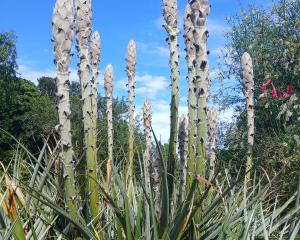Versatile salvias give colour from summer to late autumn, says Gillian Vine.
At last count, there were nearly 1000 species of salvias or sages, the largest group in the mint family.
Add hundreds of cultivated varieties in almost every flower colour, aromatic leaves — some used in cooking and herbal medicines —with the choice of annuals or perennials.
The wonder is that they haven’t taken over the gardening world completely.
Salvias can be found in most of the tropical and temperate parts of the world.
We don’t have any but Australia has S. plebeia, also native to parts of southern Asia.
Mediterranean and Mexican species generally tolerate drought conditions and poor soils but South America’s bog sage (S. uliginosa) is the opposite.
It needs fertile, moist soil to reach its full potential of 2m or more and the mid-blue flowers attract bees.
Annual salvias have been developed to give a burst of summer colour.
Developed from three species in colours of red, white, purple and blue, most are tender or half-hardy.
Grow them from seed sown under cover in spring or plants obtained from garden centres and wait until all frosts have gone before planting out into the garden.
Clary sage (S. sclarea) is one of the few biennial salvias, meaning it has a two-year lifecycle.
Its medicinal history goes back centuries and it is still used to treat eye ailments.
For colour from summer to autumn, nothing beats the shrubby perennial salvias, the majority of which are very hardy.
Of them, the best blue is S. patens, whose intensely coloured flowers are a standout in a sunny spot.
A paler version, Cambridge Blue, is not a patch on its parent although another cultivar, Guanajuato, is at least as good as the species.
Other perennial blue salvias are Indigo Spires, a cross between S. longispicata and S. farinacea; S. guaranitica Black and Blue, (Omaha Gold is the same but with variegated leaves); African Sky, a hybrid from the Auckland Botanic Gardens; and Peru Blue.
Purple Rain, Love and Wishes, So Cool Violet and Amistad are among the many purples on the market.
Two red-flowered species, S. rutilans and S. elegans, are known as pineapple sage for the smell of their crushed leaves.
The edible flowers look good in cold drinks.
Other good reds are Red Dragon and Silkes Dream.
Some of the prettiest pink salvias are Bethellii, which has deep pink blooms; Icing Sugar, whose bi-coloured flowers are dark and light pink; Pink Ice, which has pale pink flowers from December to March; and Salmon Queen, a lovely salmon-pink hybrid.
There are a few whites, like S. przewalskii White Hills, which has a hint of icy blue and a handful of yellows, of which Marshwood Lemon is a lovely example.
For those who like something a bit different, look for S. flava megalantha, a hardy Chinese salvia whose yellow flowers have a maroon lower lip. It grows to about 60cm, likes the sun but needs soil that does not dry out.
Marshwood Gardens, near Invercargill, holds of one of New Zealand’s national collections of salvia and offers a wide selection for sale, including a number bred by the nursery, among them Salmon Queen and Marshwood Lemon.
One sage (S. officinalis) is considered the main culinary herb in the salvia lineup.
Not everyone likes the taste but it seems to be making a comeback.
The secret is not to use too much, even in that old standard, sage-and-onion stuffing.
If it doesn’t appeal in the herb patch, move it to the flower garden for two versions are as decorative as they are useful.
Purple sage can be grown behind smaller pink flowers, such as nodding onion (Allium cernuum), dianthus or pansies, while variegated sage’s cream-and-green leaves fit nicely into pastel colour schemes.
Both these plants have the advantage of looking good after their companions have stopped blooming.
Like the other perennial salvias, they can be grown from cuttings but purple sage is sometimes a bit reluctant to get going, so put plenty of 20cm pieces into a pot to ensure success.
Being virtually disease-free, salvias are easy-care plants for any garden.
Not one of us
Russian sage (Perovskia atriplicifolia) is not a salvia, although it is related to them. Neither does it come from Russia. Although touted as drought-proof, it seems to perform better with some moisture, as long as its roots are in gritty, well-drained soil.


















